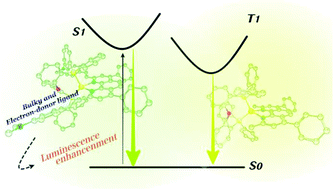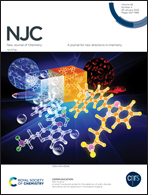Unusual fluorescence behaviour of a heteroleptic Cu(i) complex featuring strong electron donating groups on a diimine ligand†
Abstract
A novel diimine ligand (N^Nb) and the corresponding heteroleptic diimine–diphosphine Cu(I) complex (Cu–N^Nb) have been synthesized and their structural properties characterized. The N^Nb ligand is [2,9-bis-[4-(dimethylamino)phenyl]ethenyl]-4,7-diphenyl-1,10-phenanthroline, which has a bulky structure designed to retain the tetrahedral geometry of the corresponding Cu(I) complex in the excited state in order to avoid potential quenching by flattening distortion. The corresponding Cu(I) complex comprises the mentioned diimine ligand and bis-[2-(diphenylphosphino)-phenyl]ether (POP) as the diphosphine ligand. The electrochemical and photophysical properties, suitably complemented by theoretical calculations, have been studied and compared to those of a reported heteroleptic Cu(I) complex including POP and bathocuproine as the diphosphine and diimine ligands, respectively. According to both experimental and computational data, the new complex Cu–N^Nb is characterized by an unexpected luminescence behaviour that markedly differs from those typically encountered in heteroleptic diimine–diphosphine Cu(I) complexes and stems from the direct, spin-allowed radiative decay (fluorescence) of an intraligand charge transfer excited state on the bulky diimine ligand. The emission quantum yield is also surprisingly high (35%), possibly inspiring potential and alternative applications of this novel complex in luminescent devices or imaging.



 Please wait while we load your content...
Please wait while we load your content...